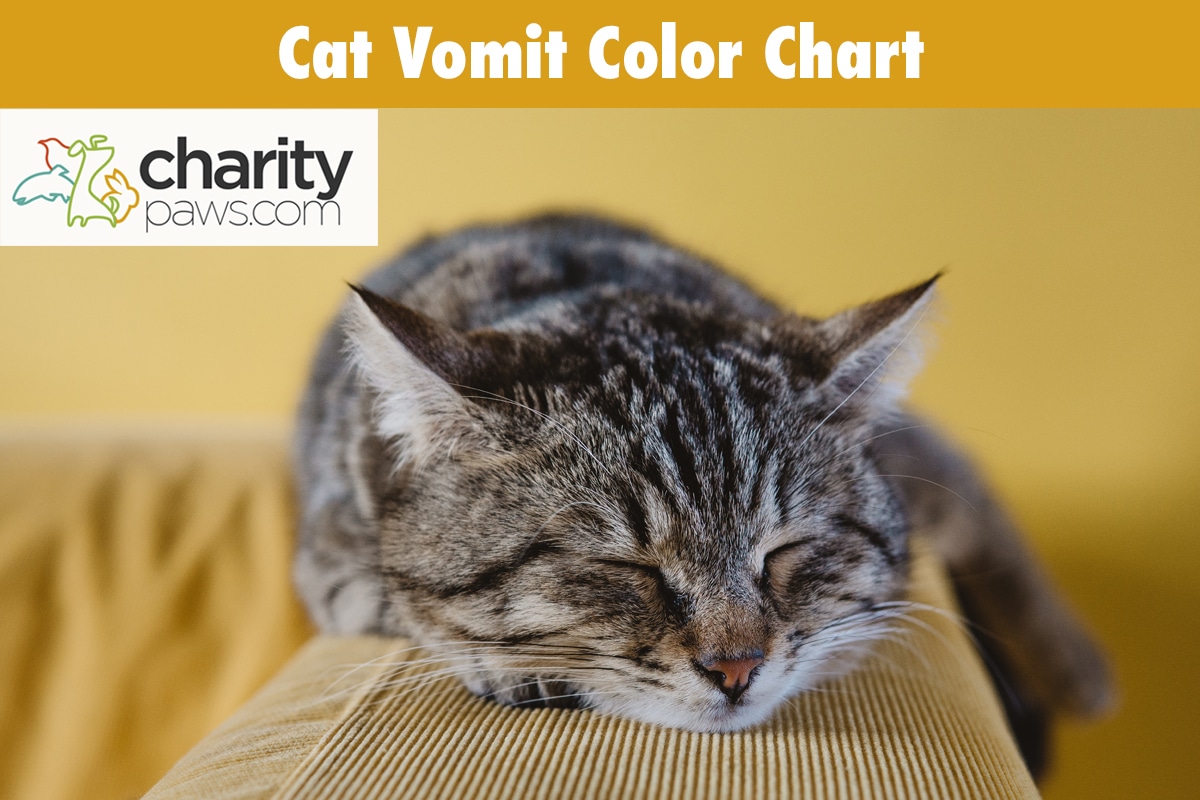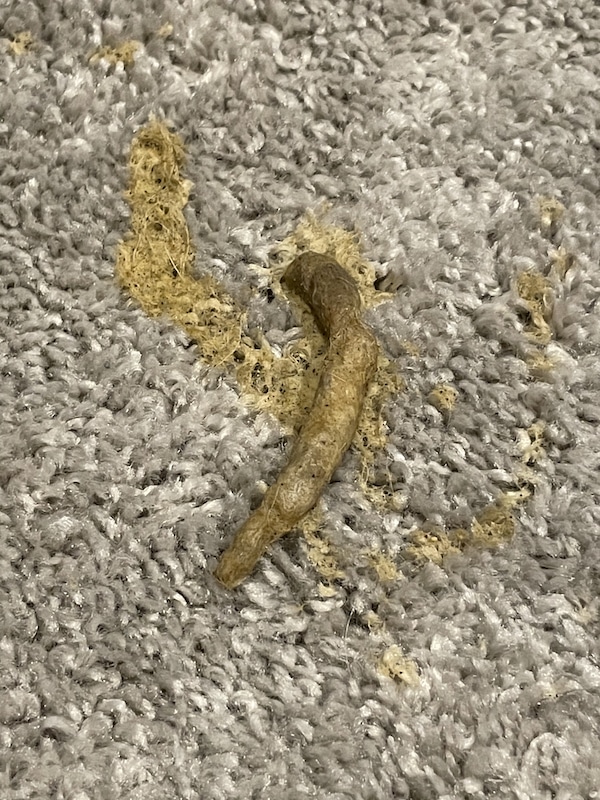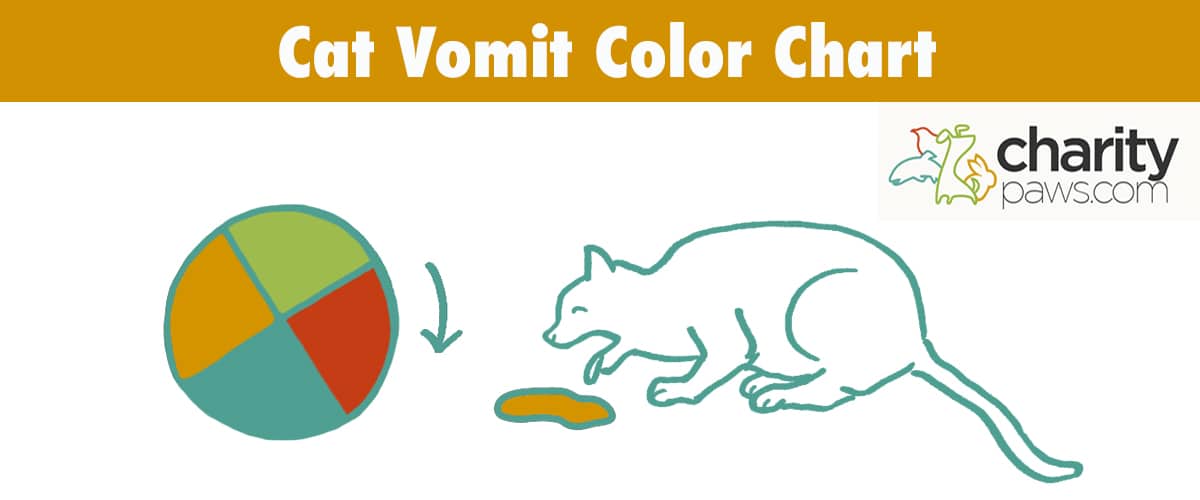If you have a feline friend in your home, they will likely vomit at some point.
Many cats will vomit occasionally without a known case, with some even hacking up frequent hairballs.
With the occasional pile of vomit found in many cat owner’s homes, it’s important to have an idea of when you should be concerned.
Being aware of the different colors of cat vomit is always helpful, as well as the types of vomit you may see.
To help you better understand any vomit found in your home, let’s get into our cat vomit color guide below.
We will also help you differentiate between hairballs and vomit, as well as offer you guidance of when it may be time to see a vet.

What Causes Vomiting In Cats?
Just like you and I, our beloved cats can experience an upset stomach from time to time.
GI upset in cats can occur due to an array of causes, ranging from harmful bacteria to infectious disease.
To help you better understand why your cat could be vomiting, let’s discuss the most common causes of vomiting in cats below.
Some of the most common factors behind a vomiting cat include:
- A sudden change in their diet
- Eating things they shouldn’t
- Viral infections
- Bacterial infections
- Intestinal parasites
- Foreign bodies
- Pancreatitis
- Chronic illness such as kidney disease, diabetes, cancer, and others
Vomiting is a common symptom of many underlying illnesses in cats, so we always suggest taking any frequent vomiting seriously.
If your cat vomits more than once in a 24 hour period, or more than once a month over an extended period, we suggest having them seen by a veterinarian.
Is It Vomit Or A Hairball?
Before we discuss the many possible types and colors of cat vomit you may see, it’s important to make sure it is actually vomit in the first place.
Hairballs and vomit are completely different in cats, but it can be challenging for some owners to distinguish between the two.
To help you identify a pile of vomit versus an occasional hairball, let’s offer you some tips.
If you are ever unsure of whether you are looking at a hairball or vomit, it’s important to examine the shape of the material.
Most cat hairballs will be slim and cylindrical, and they will resemble a tube-like structure made of hair.
As gross as it might look, this is an example of what a real cat hairball looks like. Most of the time, the vomit around the hairball is just foam or liquid stomach acids, usually the same color as the food that your cat eats.

This is due to the hairball traveling up the esophagus and forming to the shape of the esophagus itself.
Not only will most hairballs be slender and tube-like, but they will also consist of mostly hair.
There may be some stomach contents surrounding the hairball once it hits the floor, but the majority of the material will be cat hair.
The last thing to consider when differentiating between cat vomit and hairballs is how the cat is behaving.
A cat that just hacked up a hairball will likely be acting normal otherwise, while a cat with true GI upset may not.
A vomiting cat may also be slightly lethargic, they may be eating less, and they may even have diarrhea.
Is Occasional Vomiting Normal In Cats?
Occasional vomiting can be normal in some feline friends, but only if it occurs no more than once a month.
A cat that vomits more than once a month could be battling an underlying illness, ranging from inflammatory bowel disease to chronic pancreatitis.
The occasional pile of vomit on your carpet could be nothing to worry about in a cat that seems fine otherwise, but you should always take notice if this becomes a recurring issue.
If you are concerned with the frequency of your cat’s vomiting, we suggest having them seen by a veterinarian.
The Types Of Cat Vomit You May See
It may seem strange to examine your cat’s vomit when it occurs, but the appearance can offer you a bit of insight.
Though it can’t diagnose the cause of your cat’s vomiting, it can help you better understand a few key facts about their GI upset.
Let’s break it down based on each vomit type below.
Chunky Cat Vomit
Chunky cat vomit often represents the presence of food in your cat’s vomit.
This usually means that their stomach was not empty at the time of their vomiting, and that they have not yet had a chance to fully digest their last meal.
This could even mean that their last meal was the cause of their GI upset, or that they are unable to move food past their stomach for whatever reason.
Liquid Cat Vomit
Liquid cat vomit often points to the fact that a cat is vomiting on an empty stomach.
This could mean that it has been multiple hours since their last meal, or that they are even shying away from their food altogether.
Undigested Food Vomit
If there is undigested food in your cat’s vomit (visible kibble that has not lost its shape), this often means your cat has vomited soon after eating.
This could mean that your cat ate too much, they ate too quickly, or even that they were too active immediately after eating.
This is okay if it happens every now and then, but should warrant veterinary attention if it happens often.
Foamy Cat Vomit
Foam in cat vomit is a result of air meeting the vomit as the material is transferred from the stomach and out of the mouth.
The dry heaving motion often moves air back and forth in the mouth, leading to a foamy layer of the vomit once it hits the ground.
Foreign Material Vomit
If you see any strange material in your cat’s vomit that does not look like their food, this could mean that your cat is eating things they should not.
People have found items ranging from blades of grass to hair ties in their cat’s vomit, and this should always be relayed to your vet if the vomiting continues.
Cat Vomit Color Guide

Just as the different types of cat vomit can tell you certain things about your cat, so can the vomit color.
While their vomit color will not offer a definitive diagnosis, it can raise the alarm to potential underlying issues.
To help you better understand the vomit your cat produces, let’s discuss different cat vomit colors below.
Brown Vomit In Cats
Brown vomit in cats can be due to a couple different factors.
First, the most likely reason that your cat is having brown vomit is due to the color of their kibble.
Most kibbles are a brown or orange shade and this often causes their vomit to appear a shade of brown when it occurs.
The next potential cause of brown vomit in cats is due to a small trace of blood being present in the vomit.
This type of vomit will often be dark brown in color, and may even have slight traces of frank blood.
This is why we always suggest cleaning up any vomit with a white paper towel, as this will make the presence of blood more obvious to spot.
If you do think your cat has any blood in their vomit, we suggest reaching out to your vet for guidance.
Green Vomit In Cats
Green vomit in cats can occur due to a few potential factors.
First, if your cat munches on grass or other plant material regularly, this could cause a green tint to their vomit.
They may even have pieces of the plant present in their vomit if they vomited soon after their snack.
Another potential cause of green vomit in cats is the presence of bile in their vomit.
Bile assists in proper food breakdown within the cat’s stomach, so it can be present in vomit when a cat throws up with little food in its stomach.
This is often a sign of a cat that is not eating, so we always suggest having them seen by your vet.
Yellow Vomit In Cats
Similar to green vomit in cats, yellow cat vomit is typically a result of bile present in the vomit material.
This often points to the fact that a cat is not eating due to their nausea, so we always suggest having them seen by a veterinarian.
Red Vomit In Cats
Red vomit should always warrant immediate concern in cat owners.
Though there is a chance that their kibble has stained their vomit due to the vibrant dye, it can also point to the presence of blood in their vomit.
Bloody vomit can be a symptom of significant GI upset and stomach irritation and this requires immediate medical intervention when it occurs.
If your cat does eat kibble that is bright red in color, we suggest giving your vet a call to get their opinion on the matter.
If they believe the kibble is to blame for the startling color, you may be able to monitor your cat at home for any additional vomiting or GI upset.
However, if they are fearful of blood in your cat’s vomit, they will suggest bringing them in for an exam.
Black Vomit In Cats
Similar to red vomit in cats, black vomit should always warrant immediate concern.
Cats are not known to eat soil or dirt like their canine friends, so the presence of black vomit or black material in their vomit should always catch your eye.
Digested blood can transform into a dark shade of brown or black and may even have a coffee ground appearance once it is vomited.
If you ever see this in your feline companion, we suggest having them seen by a vet ASAP.
White Vomit In Cats
If your cat’s vomit appears white in color, this is often due to foam being present.
This does not make your cat’s condition any more serious, but it simply means your cat’s vomit was sloshed around in the stomach or collected air as it moved from the mouth.
However, foam is often more obvious when a cat vomits on an empty stomach, so it is possible that your cat’s nausea is preventing them from eating.
Does Cat Vomit Color Really Matter?
At the end of the day, if a cat vomits more than once in a 24 hour period, you should take their symptoms seriously no matter what color their vomit is.
While certain colors of vomit may raise an immediate alarm with cat owners, vomit of any type or color should warrant concern on our part.
The color of your cat’s vomit will not offer a concrete diagnosis, but it can offer your vet some insight when you have them seen.
If you are ever especially concerned about the color of your cat’s vomit, be sure to collect a sample in a bag and bring it along to your vet’s office.
You can also take a photo of the vomit if you do not want to collect it.
When Should My Vomiting Cat See A Vet?
As we mentioned above, a cat that vomits more than once in a 24 hour period, or more than once a month for an extended period of time, should be seen by a veterinarian.
This is even more important if they are experiencing other forms of GI upset or strange behavior, as this could point to the possibility of underlying illness.
If you are ever unsure of whether or not your cat needs an immediate trip to the vet’s office, you can always give your vet a call.
Once you explain your cat’s current symptoms and any other concerns you may have, they can help you determine the best plan of action going forward.
Be sure to bring a vomit sample if you are concerned with the appearance, or take a quick photo of the vomit to have just in case.
Final Thoughts On Our Cat Vomit Color Chart
Cat vomit can come in an array of shades and textures that can point to the potential of underlying illness.
Be sure to examine your cat’s vomit the next time you find a pile on the floor, and you can be armed with as much information as possible if you need to visit your vet.
